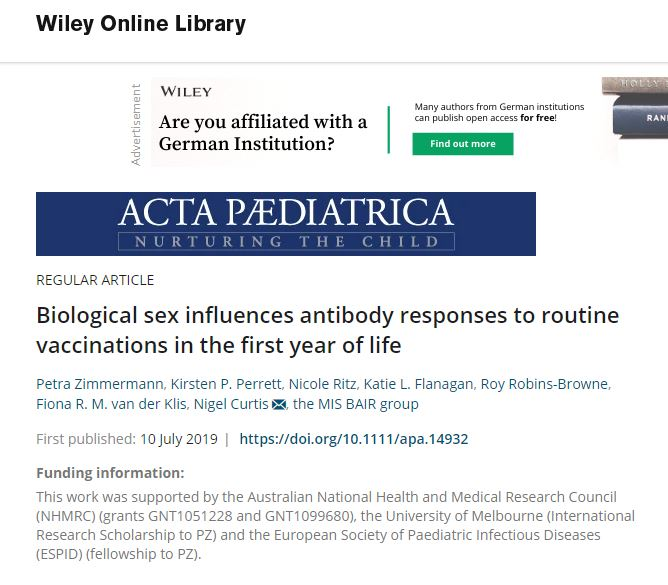Biological sex influences antibody responses to routine vaccinations in the first year of life.
We investigated the effect of early-life factors, namely sex, delivery mode, feeding method and antibiotic exposure, on antibody responses to routine vaccinations administered during the first year of life. One and seven months after the primary course of routine vaccines and 1 month after routine vaccines at 12 months of age, antibodies against 26 vaccine antigens were measured in 398 healthy infants. The geometric mean concentration (GMC) of antibodies (adjusted for effect modifiers with multiple linear regression) and the seroprotection rate for each vaccine were compared for each early-life factor. Sex had an influence on GMCs. Antibody concentrations were significantly lower at 7 months of age in females for tetanus and filamentous haemagglutinin and at 13 months of age for pertactin. In contrast, at 13 months of age, antibody concentrations were significantly higher in females for polio type 3, pneumococcal serotype 6A and measles. Sex did not have an influence on seroprotection rates. Delivery mode, feeding method and antibiotic exposure did not exert a substantial influence on vaccine antibody concentrations. There is a difference between males and females in the humoral response to routine vaccinations in the first year of life.
Authors
Petra Zimmermann; Kirsten P Perrett; Nicole Ritz; Katie L Flanagan; Roy Robins-Browne; Fiona R M van der Klis; Nigel Curtis
External link
Publication Year
Publication Journal
Associeted Project
Microbiology or Immunology
Lista de serviços
-
As antisense RNA gets intronic.As antisense RNA gets intronic.
-
Androgen responsive intronic non-coding RNAs.Androgen responsive intronic non-coding RNAs.
-
Conserved tissue expression signatures of intronic noncoding RNAs transcribed from human and mouse loci.Conserved tissue expression signatures of intronic noncoding RNAs transcribed from human and mouse loci.
-
The intronic long noncoding RNA ANRASSF1 recruits PRC2 to the RASSF1A promoter, reducing the expression of RASSF1A and increasing cell proliferation.The intronic long noncoding RNA ANRASSF1 recruits PRC2 to the RASSF1A promoter, reducing the expression of RASSF1A and increasing cell proliferation.
-
Antisense intronic non-coding RNA levels correlate to the degree of tumor differentiation in prostate cancer.Antisense intronic non-coding RNA levels correlate to the degree of tumor differentiation in prostate cancer.
-
Insight Into the Long Noncoding RNA and mRNA Coexpression Profile in the Human Blood Transcriptome Upon Leishmania infantum Infection.Insight Into the Long Noncoding RNA and mRNA Coexpression Profile in the Human Blood Transcriptome Upon Leishmania infantum Infection.
-
Long non-coding RNAs associated with infection and vaccine-induced immunityLong non-coding RNAs associated with infection and vaccine-induced immunity
-
Comparative transcriptomic analysis of long noncoding RNAs in Leishmania-infected human macrophagesComparative transcriptomic analysis of long noncoding RNAs in Leishmania-infected human macrophages
-
SARS-CoV-2 Selectively Induces the Expression of Unproductive Splicing Isoforms of Interferon, Class I MHC, and Splicing Machinery Genes.SARS-CoV-2 Selectively Induces the Expression of Unproductive Splicing Isoforms of Interferon, Class I MHC, and Splicing Machinery Genes.

